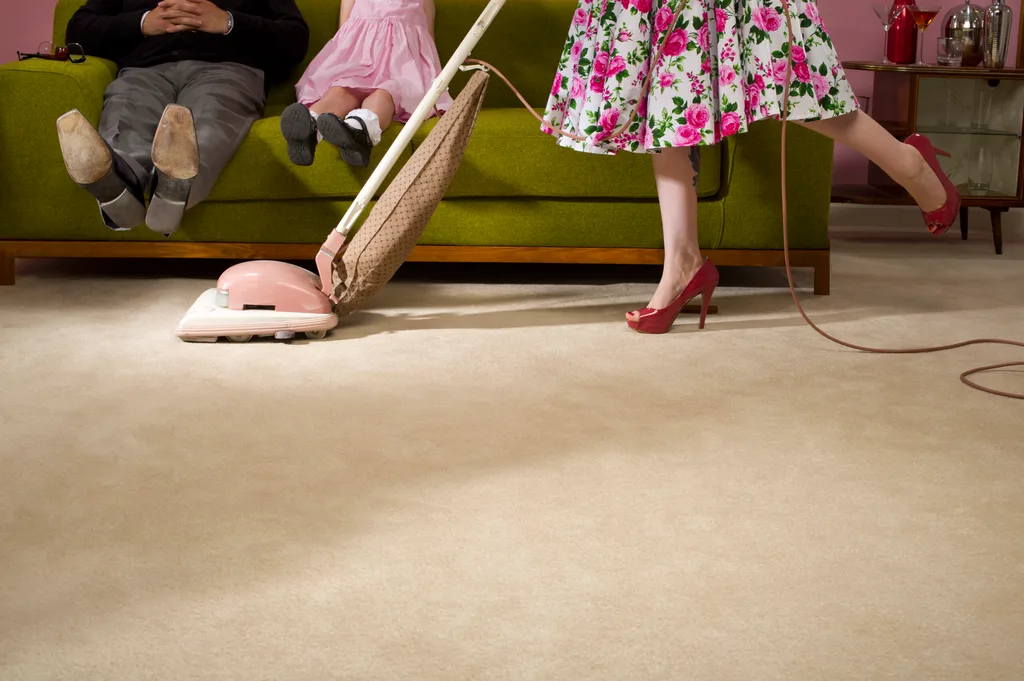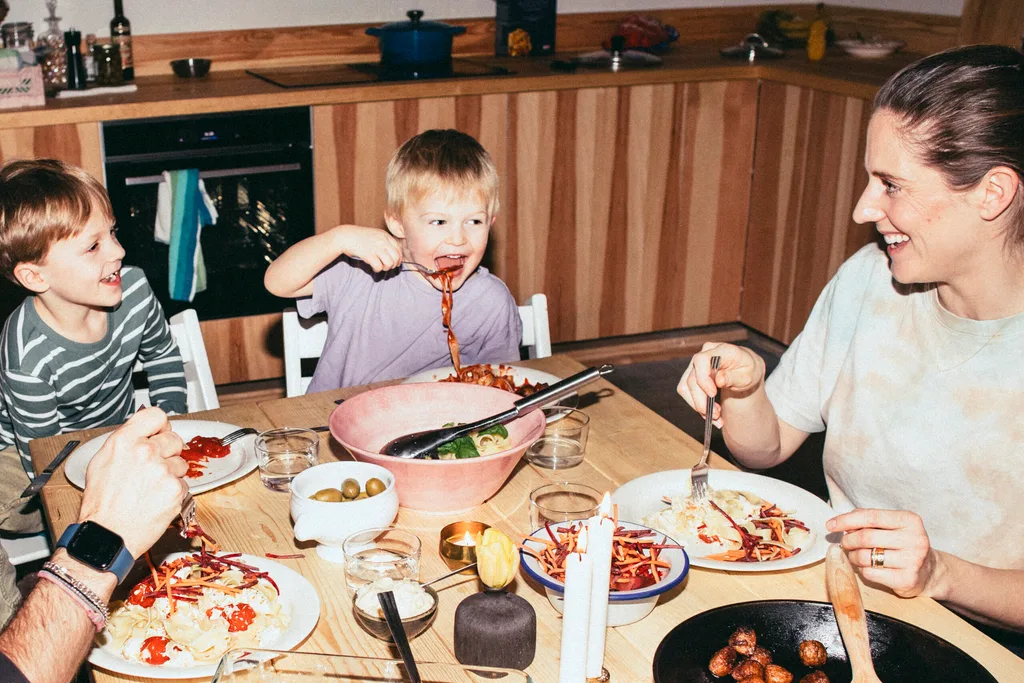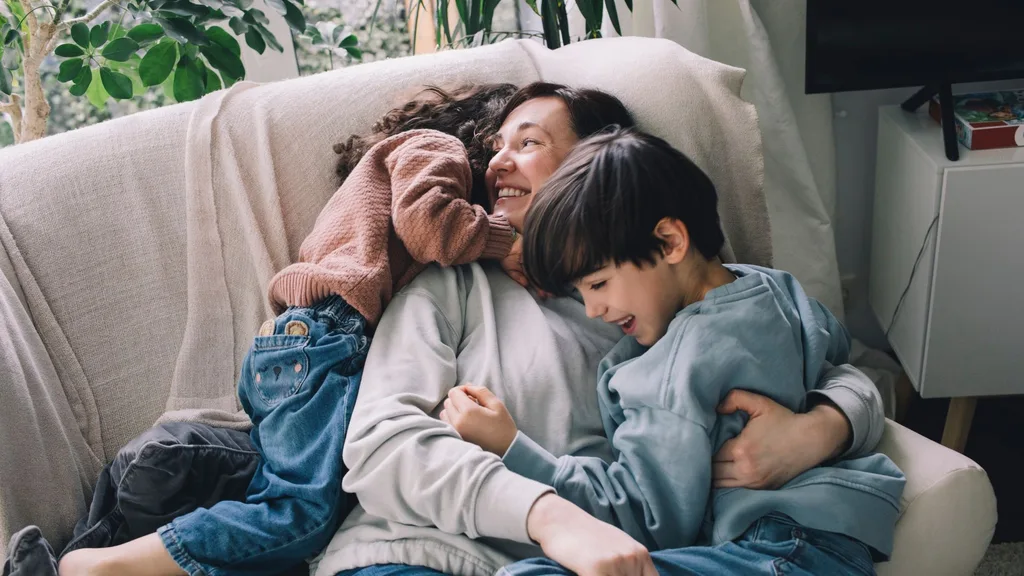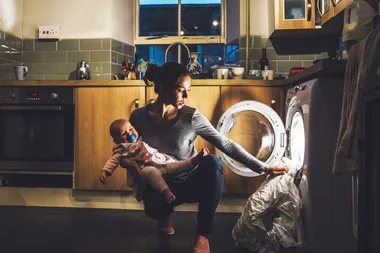When Gretchen Adler’s three children want a snack, their mother doesn’t hand them supermarket-bought sweets or packaged chips. Instead, the 38-yearold goes into the kitchen to make them “Goldfish” crackers and “Oreo” biscuits – from scratch.
A self-described traditional mum and wife, Adler’s TikTok and Instagram accounts (@gretchy) are filled with videos of her cooking or baking food for her young kids, aged eight, six and three. More than half a million people follow her across her social media channels, watching as she creates cheese, flour, muffins, bread, and a variety of sauces, from home-grown ingredients. Adler proudly states her children have never eaten “ultra processed snacks” and she espouses the belief “food is medicine. It’s also poison, so choose wisely”.
While the stay-at-home mum (SAHM) has her fair share of fans, she also has a large number of detractors. A one-minute viral video of Adler making her children snacks produced
thousands of negative comments, most of them pointing out the “privilege” of this kind of lifestyle, while others expressed anger that she was seemingly judging them for how they fed their own children.
“People take it as a personal attack when they see someone doing things differently from them. This is [due to] an insecurity they may have about their own lives, and something they need to address personally,” Adler tells marie claire. “There are many who feel that I am privileged to be a stay-at home mother or that I have too much time on my hands because I don’t work.

I do not spend much time responding to the negativity because my life is very fast-paced and fulfilling. My mission is to spread good health to the world, so I am much more concerned about moving forward with my mission, rather than conversing with the naysayers.
Motherhood is demanding and full-time and we are required to make choices about how we want to lead our lives. I choose to live my life the way I do, which is not reflective of how someone else chooses to live theirs.”
Adler is part of the “tradwives” – short for traditional wives – movement that began in 2018 on Instagram and TikTok and rose to prominence during the pandemic. Tradwives are described as women who choose to stay at home and focus their time and attention on caring for their children and domestic duties, rather than build a professional working career.
Often shown cooking in the kitchen, tradwives lean into slow-living that harks back to “simpler times”. Those times were, of course, not as strong on women’s rights, which is one of the reasons many feminists have an issue with the tradwife trend.
Tradwives are also generally characterised as being subservient and financially dependent on their husbands, which also draws criticism. If the definition of a tradwife has similarities with a SAHM, that’s because they are invariably linked.
Just as “housewife” became “stay-at home mum/wife”, tradwife is another evolution of a woman who prioritises the home. However, since tradwives are predominantly on social media, their portrayal is highly curated and exaggerated.
Well-known tradwives, such as the softly spoken Nara Smith, ultra-feminine Estee Williams, and Ballerina Farm’s Hannah Neeleman (often considered the queen of tradwives), favour a 1950s aesthetic, are conventionally beautiful, and always appear perfectly put-together.
The rise of these “flawless” tradwives has brought a renewed focus on the tension between stay-at-home mothers and working mothers, the notion of feminism and the stigma stay-at-home mums face (aka “motherism”).
“I believe this all stems from the early women’s liberation movement, which sought to address an inherent bias in patriarchal culture that said that women – their intellect, their capacity and their contribution to society and culture – were inferior to men because women did not work.

Raising children and running a household was not deemed as valuable or respectable as employment,” says clinical psychologist and founder of The Wellness Fountain in Sydney,
Dr Maria-Elena Lukeides.
“Early in the [women’s liberation] movement, it meant women were no longer as vulnerable in relationships. They could make choices because they could support themselves and their children. It also meant women could find personal fulfilment in places other than their home or motherhood. Over time this led to pressure on women to ‘have it all’,” she continues.
“Now, when a mother chooses to stay at home to raise her family she is viewed as regressive or labelled ‘anti-feminist’. A traditional woman’s role as nurturer and homemaker needs to be seen as equally important as the role of a woman in the workplace.
“New-age feminism should be about women having the right to make the choice about how they live their life.”
While Lukeides says being a tradwife is a personal choice that doesn’t need justification – “If they want to choose to be a tradwife, more power to them” – she also says the tradwife trend could potentially set back the SAHM movement.
“Tradwives often present an idealised, unrealistic version of domestic life that doesn’t reflect the reality for most stay-at-home mums,” explains Lukeides.
“This can create unrealistic expectations and further stigmatise stay-at-home mums who don’t meet this perfect image. Some stay-at-home mums might not make it out of their pyjamas until lunchtime. And, even then, they would throw on some activewear because they likely don’t have the time or energy to get perfectly preened.
The tradwife movement tends to lean into traditional gender roles and sometimes emphasises female submission, which can reinforce negative stereotypes about stay-at home mothers being subservient or less empowered than working mums.”
Popular YouTube personality and stay-at-home mum Abigail “Abby” Roth (@thefirstgensahm) is often labelled a tradwife due to her dedication to “classic” living and traditional values.
But the 31-year-old, who is the sister of conservative US commentator Ben Shapiro, does not consider herself a tradwife and takes issue with some of the trend’s attributes. “I just don’t agree with the concept of a woman being subjugated by her husband, in the sense that she must be meek before him, can’t voice her disagreements with him or call him out on bad behaviour.
The best part of marriage is that each person encourages the other to grow and change for the better through their input as equal partners in the relationship,” Roth tells marie claire.
“Another aspect of the tradwife concept I don’t agree with is the idea that a woman who must work to help support her family is in some way less feminine or womanly than a woman who can be at home. A woman who works because that is the most direct way she can serve her family’s real needs is absolutely fulfilling her womanhood.”

At the same time, Roth holds views that might be considered radically traditional by some. “My ‘classic’ perspective on work is that women should not choose to pursue a career or to work as a matter of personal self-fulfilment when they could devote themselves fully to their families,” explains the mum-of-two.
“The question is always how is your family best served, and women have a beautiful and truly unique power to care for their loved ones, which brings light to everyone in the family’s life. Where women can embrace that, they should.”
A 2020 study of tradwives by Oxford University researcher Dr Julia Ebner found that up to 30,000 women in the United Kingdom described themselves as tradwives.
These women wanted to “return to exaggerated notions of masculinity and femininity” and made misogynist statements including, “Women’s highest value to men is her sexual value, and she’s most valuable when she’s in her sexually pristine state.”
One of Australia’s leading experts on right-wing extremism and terrorism, Dr Kristy Campion, says there are two types of tradwives: those who adopt the tradwife lifestyle as a private and nonpolitical decision, and far-right tradwives who see their position as a political one.
“Far-right tradwives often use their platforms to project far-right politics and ideological positions, often using a soft, cottagecore-type aesthetic,” explains Campion. “They may believe hat they are adopting a purer form of femininity before it was supposedly ‘corrupted’ by modernity, left-wing progressivism, and feminism.
Their audience might not even be aware of the beliefs being projected within the content. This socialises people to far-right views without transparency, and can serve to promote or recruit people into the various movements.
What might at first glance be content glorifying home cooking, a simpler life and specific marital behaviours, can also contain messaging that is controlling, anti-immigration, racist, intolerant, homophobic, and often hostile to other views and behaviours.”
Campion’s colleague at Charles Sturt University Dr Kiriloi M. Ingram, who specialises in political science, feminist international security and terrorism studies, adds that far-right tradwives think rearing ideologically and racially pure children can weaken and undermine the out-group, that is, non-white and gender-diverse peoples, and more broadly, feminists.
However, Ingram notes that it is important that non-far-right tradwives are not demonised for placing value in their domestic responsibilities.

“If we strip back the gloss of social media and dig deeper – beyond the notion that being a tradwife is just a ‘trend’ – we can see there is a broader historical and global push to recognise that women’s social, reproductive and domestic responsibilities ought to be valued,” she says.
“Indeed, feminists have been pushing for these responsibilities to be rightly viewed as skilled labour – a position that I personally agree with.
“Women are not homogenous, and feminists and feminisms are not homogenous. As a result, there is inevitably always going to be differences across time and contexts in how different women
view empowerment and how they themselves seek to exercise their agency.
The key, from my perspective, is that we ought to allow for this difference and plurality, so that women have agency and the ability to make choices securely and without harm.”
Statistics show that SAHMs in Australia are on the decline, likely due to the high cost-of-living and housing crisis.
Bucking the trend is radio announcer and former Married At First Sight (MAFS) star Bella Frizza, who recently gave up her decade-long radio role to become a SAHM in order to spend more time with her two-year-old son, Finn. Deciding to step away from her dream job and take up a remote marketing role wasn’t an easy decision, but it’s one the 39-year-old is glad she made.
“I was coming home from work exhausted and I couldn’t be that rock for Finn,” Frizza tells marie claire.
“He would be exhausted from daycare and I would just want to get him to bed. That’s not a life. That’s not how I want him to experience his childhood. And because of what? Because I want to be a career woman? If I’ve chosen to have this baby in my life, then I want to be the best person I can be for him.
“When I was on MAFS in 2016, I was relentless about not wanting to have kids,” continues Frizza. “I just wanted my career and a husband. And I got absolutely trolled for not wanting children. But now that I’m here, I’m like, ‘OK, I love being a mum.’ It’s the most incredible job I’ve ever had. But I still stand by anyone who doesn’t want kids. And I stand by anyone who does want kids, and anyone who wants to be a stay-at-home mum or a working mum.
“There is no ‘one-size-fits-all’. Everyone makes their own choice and that’s what’s important. Live and let live.”
Related articles:
- Nara Smith Is Pushing Back On People Reducing Her To A ‘Trad Wife’
- 9 Moments From the ‘Ballerina Farm’ Interview That Have Us Rethinking Trad Wife Content
- ‘The Secret Lives Of Mormon Wives’ Is Surprisingly Feminist



